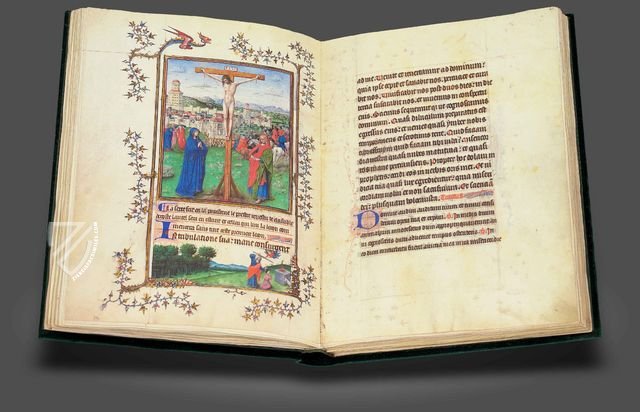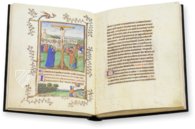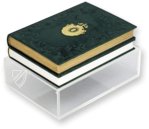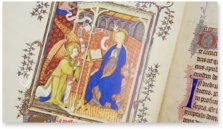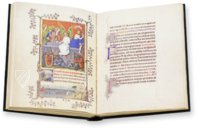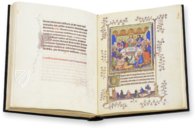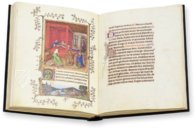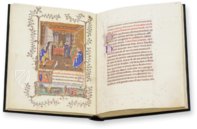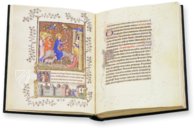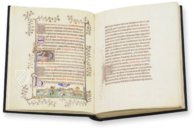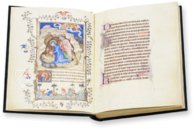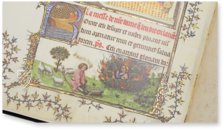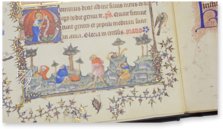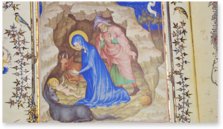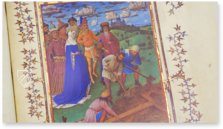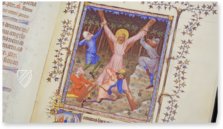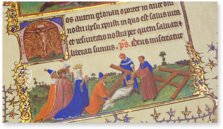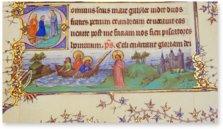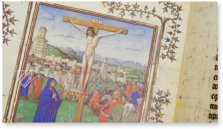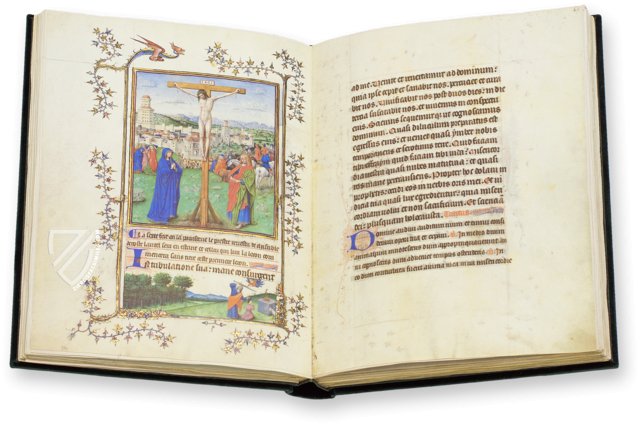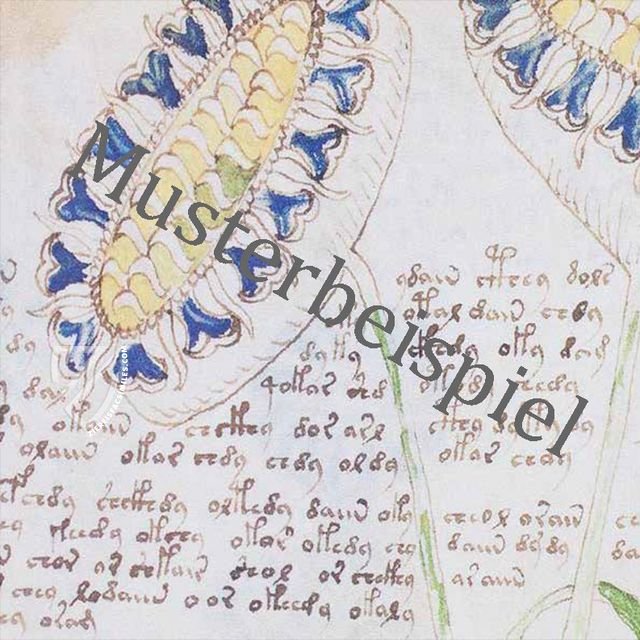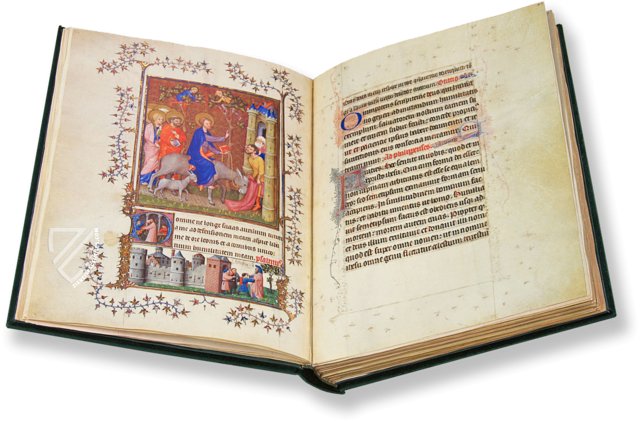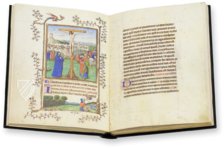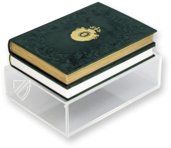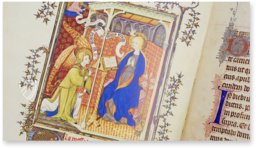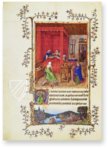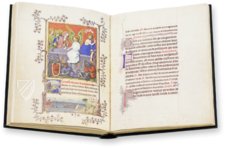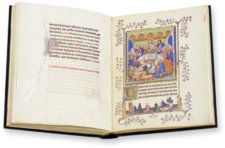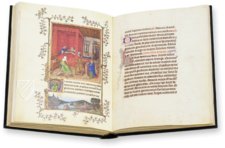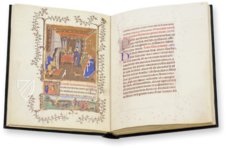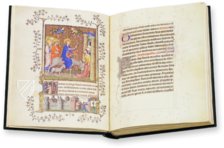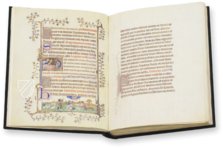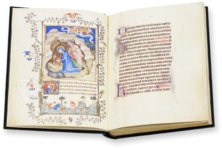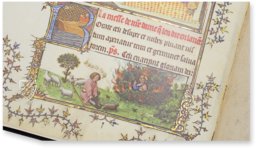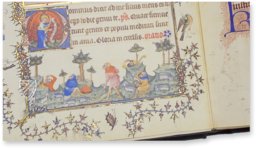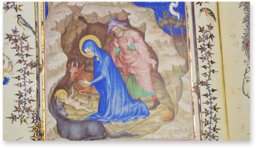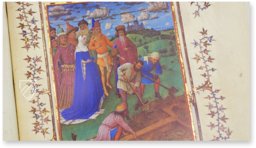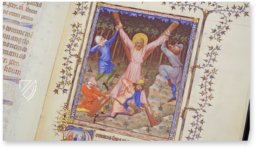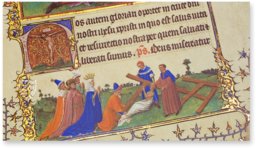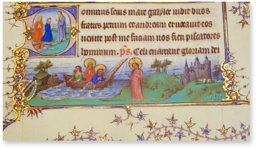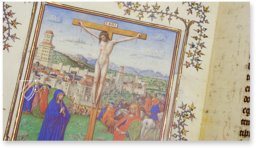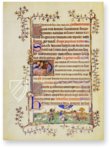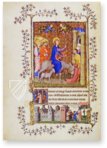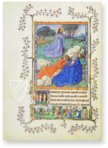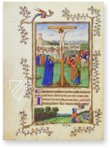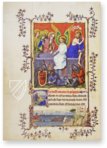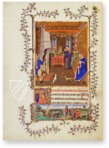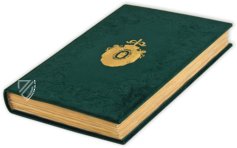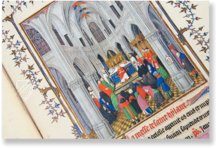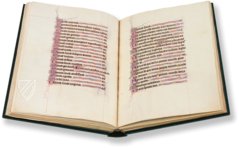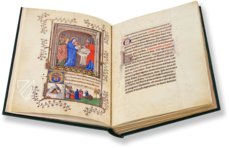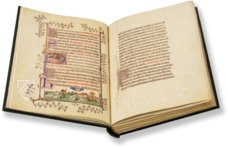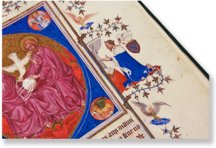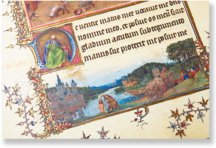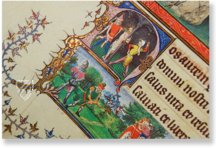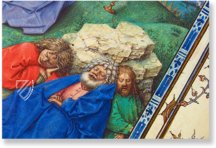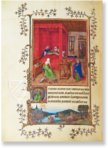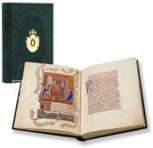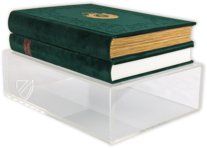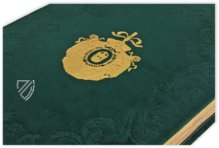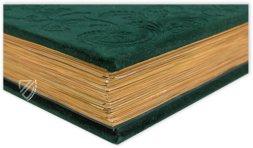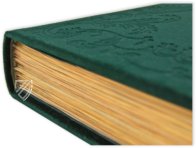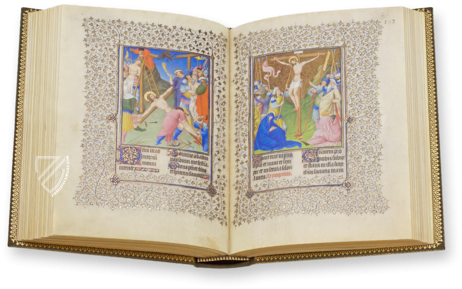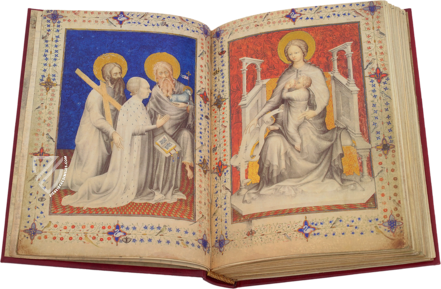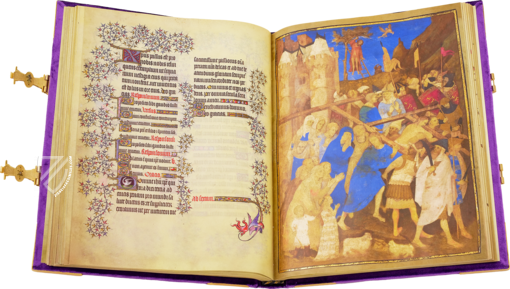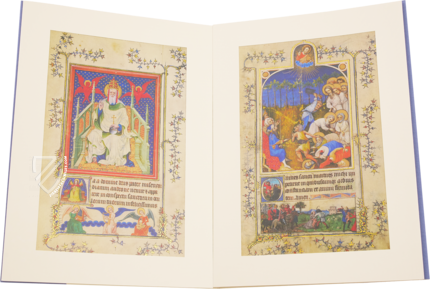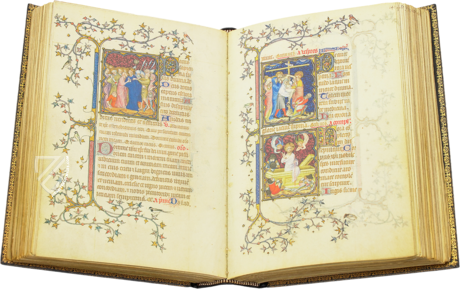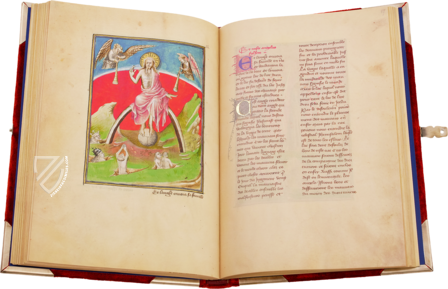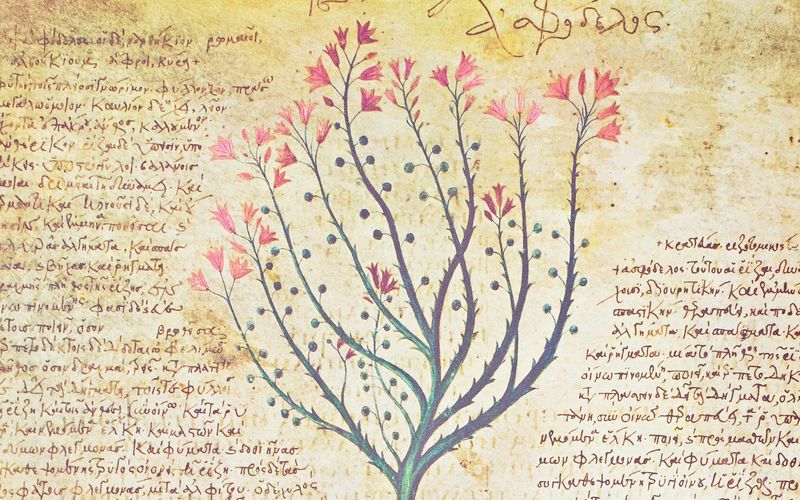Turin-Milan Hours
(1,000€ - 3,000€)
Jean de Valois, Duc de Berry (1340-1416), commissioned this astounding book project before the end of the 14th century: the so-called Turin-Milan Hours, which were created by some of the greatest book artists of medieval Europe over a period of more than half a century. In three work periods in the time around 1380/90 and in the 1440s, no fewer than five hands contributed to the manuscript, which was repeatedly divided into larger fragments and at times was also in the possession of Count John III of Holland (1374-1425) and Philip the Good (1396-1467). Among others, Jan van Eyck (around 1390-1441) was probably involved in the incredibly high-quality decoration of this artistic milestone of Gothic book art. Seven pioneering illuminated pages are attributed to him. Despite the religious themes, they show impressively realistic interiors and many everyday details as well as hitherto unknown wide landscapes and naturalistic light settings. These are the only surviving miniatures by the hand of the gifted Flemish panel painter.
Turin-Milan Hours
Hidden behind the simple title of the so-called Turin-Milan Hours is hidden a handwritten and illuminated codex which possesses a unique position in the history of mediaeval manuscripts. Over the course of time, it was continuously divided into fragments and found itself in the possession of the most important noble houses in Europe. The book gained its title from its then-residence in the house of Savoy, the ruling house of Milan, where it emerged from the National Library of Turin. The work combines the stylistic elements of two books of hours, one of which bore the title Très Belles Heures de Notre-Dame and the other Heures de Turini. It is an incomparable, unique prayer book and missal, which was fashioned by a collection of the greatest artists of the Middle Ages over a time period comprising multiple generations. The book of hours contains 28 impressive, full-page miniatures. Particular fame was achieved by several miniatures that were probably created by Jan van Eyck – the founder of portrait art and father of the great Old Dutch painting-style.
The Origin Story of the Masterpiece
The Turin-Milan Hours was produced sometime between 1380/90 and the 1440’s in Paris and Flanders. Originally, the book of hours was an underlying part of the monumental work that had been commissioned by the Burgundian Duke Jean de Berry, namely the Très Belles Heures de Notre-Dame. Two unbelievably-talented illuminators saw to the furnishing of this work until the death of the duke in the year 1416. By way of inheritance, the incomplete work reached the possession of Count Johann von Holland, who commissioned Jan van Eyck with its completion. Only a short time later, he was appointed to the court of Philip the Good, where he continued to grapple with the monumental project. Van Eyck’s death in the year 1441 abruptly ended work on the book of hours. In order to pay tribute to the great artist and to properly esteem his work, Duke Philip commissioned a further, obscure painter from Flanders who completed the codex according to the stylistic examples of van Eyck.
The Top Lineup of Illuminators
The most diverse theories exist about the illuminators of the 28 miniature pages. One of the artists, who devoted himself to the manuscript in the last quarter of the 14th century, is identified with the name of convenience “Master of the Parament of Narbonne”. A few miniatures were made in a particularly sophisticated painting technique, the so-called grisaille painting-style. These pictures were produced by an artist known as “Master G”. Hidden behind the mysterious Master G is most probably Jan van Eyck. The unmistakable depictions definitely mirror the style of the important artist. The brothers of van Eyck, Barthélemy and Hubert van Eyck, probably took part in the creation of the codex. There exists no other work from this historical epoch that was worked on by such an astounding artistic collective.
Historically Significant Illumination
The Turin-Milan Hours is an absolute magnum opus of Gothic illumination**. Some of the miniatures are counted among the most beautiful examples of Late-Gothic painting in France, while others demonstrate a revolutionary, illusionist style. These very same new kinds of depictions founded the Old Dutch Style of painting, which is **still of immeasurable significance for art history. The pictures ascribed to Jan van Eyck particularly astound historians and historically-interested book-lovers. They show the legendary abilities of the artist, which lend a higher meaning to everyday spaces with the help of masterfully integrated light reflections in the paintings. At the same time, it was van Eyck who first understood how to create realistic portraits. Furthermore, he led painting toward a microscopically exact reflection of reality. The significance of the *Turin-Milan Hours for the history of book art is irreplaceable.
Codicology
- Alternative Titles
- Turin-Mailänder Stundenbuch
Libro d'ore di Torino-Milano - Size / Format
- 252 pages / 28.4 × 20.3 cm
- Origin
- France
- Date
- Between 1380/90 and 1440
- Epochs
- Style
- Genre
- Script
- Gothic Textura
- Illustrations
- 33 large miniatures; 36 bas-de-page scenes; 36 historiated initials; 12 calender illuminations with the Labours of the Month
- Content
- Liturgy of the Hours
- Patron
- Jean, Duke of Berry (1340–1460); a member of the House Bavaria–Holland
- Artist / School
- Jean d'Orleans
Jan van Eyck
Hubert van Eyck
Master of the Life of John the Baptist
Master of the Parament of Narbonne, and others - Previous Owners
- Robinet D'Estampes
House of Bavaria–Holland
House of Savoy
Prince Gian Giacomo Trivulzio
Turin-Milan Hours
Judas Receives Thirty Pieces of Silver
Treachery is afoot despite the cozy setting of this room with Gothic windows, a roaring fire, and dogs. The richly dressed figures are conspiring against Jesus and the bareheaded man is Judas, shown receiving his infamous bribe: “Then one of the twelve, called Judas Iscariot, went to the chief priests and said, ‘What are you willing to give me if I deliver Him to you?’ And they counted out to him thirty pieces of silver. So from that time he sought opportunity to betray Him.” (Rev. 26:14-15)
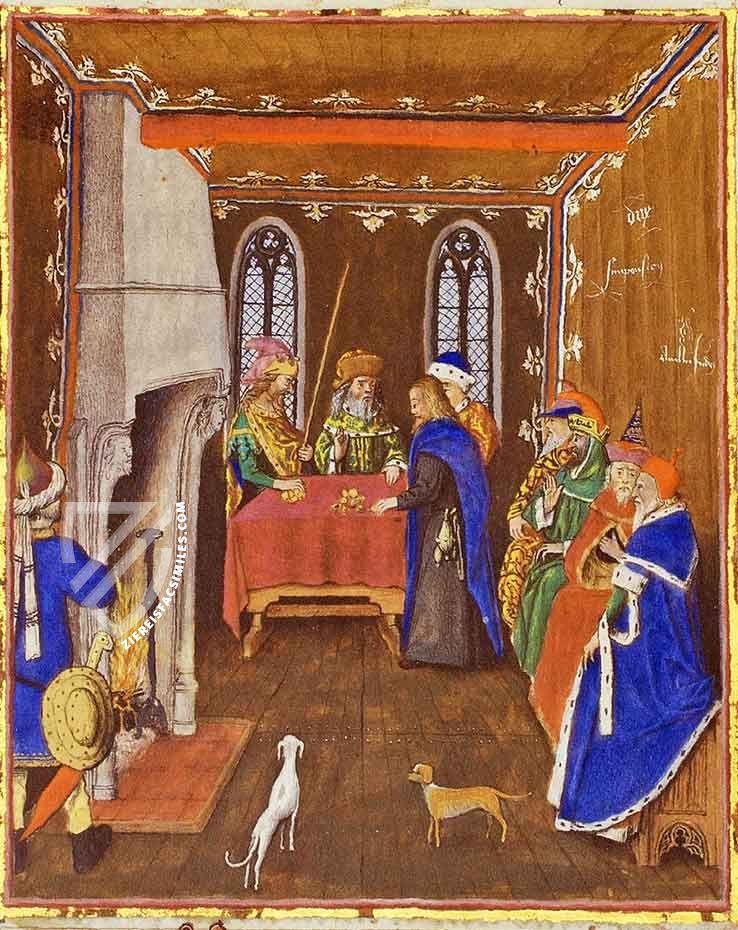
Turin-Milan Hours
Birth of John the Baptist
This miniature is a splendid sample of the magnum opus of Gothic illumination at hand. The scene is depicted in a richly furnished interior by the “Hand G”, believed to be Jan van Eyck, and is distinguished by its detail, subtlety, and illusionist realism. The bas-de-page miniature depicts Jesus’s baptism in a gorgeous landscape with a Gothic castle across the River Jordan.
The primary miniature makes wonderful use of perspective that extends into the next room, where a man in a red hat is reading. Baby John’s halo is rendered by delicate strokes of gold ink, and the cardinal-red of his birthing bed is magnetic. Aside from the various everyday objects, one sees a stained glass window, a dog with a bone, a cat drinking milk, and a toddler playing.
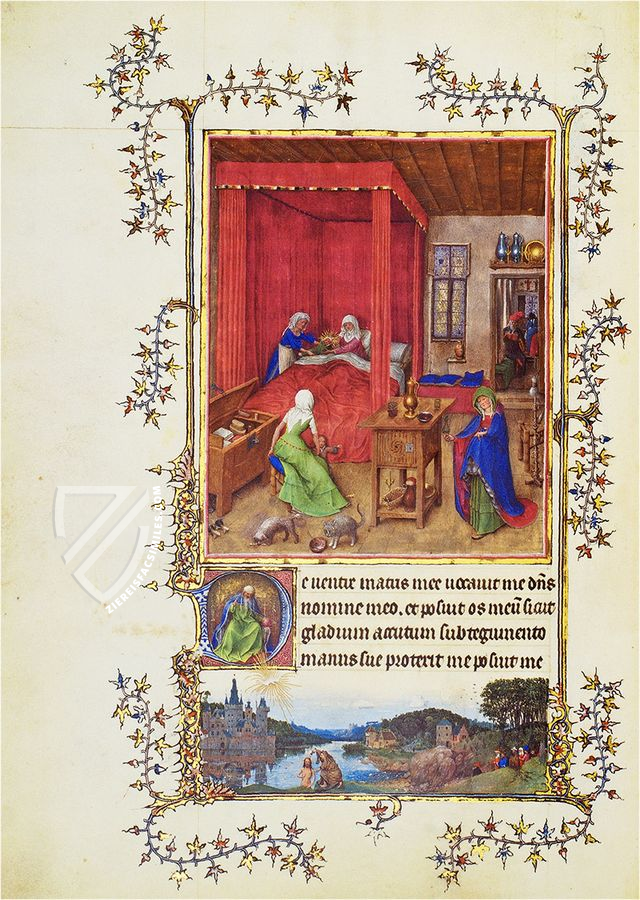
#1 Turin-Mailänder Stundenbuch
Language: English, French, German
(1,000€ - 3,000€)
#2 Blätter im Louvre (Collection)
Languages: German, French
(under 1,000€)
#3 Turin-Mailänder Stundenbuch
Language: Italian
(1,000€ - 3,000€)
- Treatises / Secular Books
- Apocalypses / Beatus
- Astronomy / Astrology
- Bestiaries
- Bibles / Gospels
- Chronicles / History / Law
- Geography / Maps
- Saints' Lives
- Islam / Oriental
- Judaism / Hebrew
- Single Leaf Collections
- Leonardo da Vinci
- Literature / Poetry
- Liturgical Manuscripts
- Medicine / Botany / Alchemy
- Music
- Mythology / Prophecies
- Psalters
- Other Religious Books
- Games / Hunting
- Private Devotion Books
- Other Genres
- Afghanistan
- Armenia
- Austria
- Belgium
- Belize
- Bosnia and Herzegovina
- China
- Colombia
- Costa Rica
- Croatia
- Cyprus
- Czech Republic
- Denmark
- Egypt
- El Salvador
- Ethiopia
- France
- Germany
- Greece
- Guatemala
- Honduras
- Hungary
- India
- Iran
- Iraq
- Israel
- Italy
- Japan
- Jordan
- Kazakhstan
- Kyrgyzstan
- Lebanon
- Liechtenstein
- Luxembourg
- Mexico
- Morocco
- Netherlands
- Palestine
- Panama
- Peru
- Poland
- Portugal
- Romania
- Russia
- Serbia
- Spain
- Sri Lanka
- Sweden
- Switzerland
- Syria
- Tajikistan
- Turkey
- Turkmenistan
- Ukraine
- United Kingdom
- United States
- Uzbekistan
- Vatican City
- A. Oosthoek, van Holkema & Warendorf
- Aboca Museum
- Ajuntament de Valencia
- Akademie Verlag
- Akademische Druck- u. Verlagsanstalt (ADEVA)
- Aldo Ausilio Editore - Bottega d’Erasmo
- Alecto Historical Editions
- Alkuin Verlag
- Almqvist & Wiksell
- Amilcare Pizzi
- Andreas & Andreas Verlagsbuchhandlung
- Archa 90
- Archiv Verlag
- Archivi Edizioni
- Arnold Verlag
- ARS
- Ars Magna
- ArtCodex
- AyN Ediciones
- Azimuth Editions
- Badenia Verlag
- Bärenreiter-Verlag
- Belser Verlag
- Belser Verlag / WK Wertkontor
- Benziger Verlag
- Bernardinum Wydawnictwo
- BiblioGemma
- Biblioteca Apostolica Vaticana (Vaticanstadt, Vaticanstadt)
- Bibliotheca Palatina Faksimile Verlag
- Bibliotheca Rara
- Boydell & Brewer
- Bramante Edizioni
- Bredius Genootschap
- Brepols Publishers
- British Library
- C. Weckesser
- Caixa Catalunya
- Canesi
- CAPSA, Ars Scriptoria
- Caratzas Brothers, Publishers
- Carus Verlag
- Casamassima Libri
- Centrum Cartographie Verlag GmbH
- Chavane Verlag
- Christian Brandstätter Verlag
- Circulo Cientifico
- Club Bibliófilo Versol
- Club du Livre
- CM Editores
- Collegium Graphicum
- Collezione Apocrifa Da Vinci
- Comissão Nacional para as Comemorações dos Descobrimentos Portugueses
- Coron Verlag
- Corvina
- CTHS
- D. S. Brewer
- Damon
- De Agostini/UTET
- De Nederlandsche Boekhandel
- De Schutter
- Deuschle & Stemmle
- Deutscher Verlag für Kunstwissenschaft
- DIAMM
- Droz
- E. Schreiber Graphische Kunstanstalten
- Ediciones Boreal
- Ediciones Grial
- Ediclube
- Edições Inapa
- Edilan
- Editalia
- Edition Deuschle
- Edition Georg Popp
- Edition Leipzig
- Edition Libri Illustri
- Editiones Reales Sitios S. L.
- Éditions de l'Oiseau Lyre
- Editions Medicina Rara
- Editorial Casariego
- Editorial Mintzoa
- Editrice Antenore
- Editrice Velar
- Edizioni Edison
- Egeria, S.L.
- Eikon Editores
- Electa
- Emery Walker Limited
- Enciclopèdia Catalana
- Eos-Verlag
- Ephesus Publishing
- Ernst Battenberg
- Eugrammia Press
- Extraordinary Editions
- Fackelverlag
- Facsimila Art & Edition
- Facsimile Editions Ltd.
- Facsimilia Art & Edition Ebert KG
- Faksimile Verlag
- Feuermann Verlag
- Folger Shakespeare Library
- Franco Cosimo Panini Editore
- Friedrich Wittig Verlag
- Fundación Hullera Vasco-Leonesa
- G. Braziller
- Gabriele Mazzotta Editore
- Gebr. Mann Verlag
- Gesellschaft für graphische Industrie
- Getty Research Institute
- Giovanni Domenico de Rossi
- Giunti Editore
- Graffiti
- Grafica European Center of Fine Arts
- Guido Pressler
- Guillermo Blazquez
- Gustav Kiepenheuer
- H. N. Abrams
- Harrassowitz
- Harvard University Press
- Helikon
- Hendrickson Publishers
- Henning Oppermann
- Herder Verlag
- Hes & De Graaf Publishers
- Hoepli
- Holbein-Verlag
- Houghton Library
- Hugo Schmidt Verlag
- Idion Verlag
- Il Bulino, edizioni d'arte
- ILte
- Imago
- Insel Verlag
- Insel-Verlag Anton Kippenberger
- Instituto de Estudios Altoaragoneses
- Instituto Nacional de Antropología e Historia
- Introligatornia Budnik Jerzy
- Istituto dell'Enciclopedia Italiana - Treccani
- Istituto Ellenico di Studi Bizantini e Postbizantini
- Istituto Geografico De Agostini
- Istituto Poligrafico e Zecca dello Stato
- Italarte Art Establishments
- Jan Thorbecke Verlag
- Johnson Reprint Corporation
- Josef Stocker
- Josef Stocker-Schmid
- Jugoslavija
- Karl W. Hiersemann
- Kasper Straube
- Kaydeda Ediciones
- Kindler Verlag / Coron Verlag
- Kodansha International Ltd.
- Konrad Kölbl Verlag
- Kurt Wolff Verlag
- La Liberia dello Stato
- La Linea Editrice
- La Meta Editore
- Lambert Schneider
- Landeskreditbank Baden-Württemberg
- Leo S. Olschki
- Les Incunables
- Liber Artis
- Library of Congress
- Libreria Musicale Italiana
- Lichtdruck
- Lito Immagine Editore
- Lumen Artis
- Lund Humphries
- M. Moleiro Editor
- Maison des Sciences de l'homme et de la société de Poitiers
- Manuscriptum
- Martinus Nijhoff
- Maruzen-Yushodo Co. Ltd.
- MASA
- Massada Publishers
- McGraw-Hill
- Metropolitan Museum of Art
- Militos
- Millennium Liber
- Müller & Schindler
- Nahar - Stavit
- Nahar and Steimatzky
- National Library of Wales
- Neri Pozza
- Nova Charta
- Oceanum Verlag
- Odeon
- Orbis Mediaevalis
- Orbis Pictus
- Österreichische Staatsdruckerei
- Oxford University Press
- Pageant Books
- Parzellers Buchverlag
- Patrimonio Ediciones
- Pattloch Verlag
- PIAF
- Pieper Verlag
- Plon-Nourrit et cie
- Poligrafiche Bolis
- Presses Universitaires de Strasbourg
- Prestel Verlag
- Princeton University Press
- Prisma Verlag
- Priuli & Verlucca, editori
- Pro Sport Verlag
- Propyläen Verlag
- Pytheas Books
- Quaternio Verlag Luzern
- Reales Sitios
- Recht-Verlag
- Reichert Verlag
- Reichsdruckerei
- Reprint Verlag
- Riehn & Reusch
- Roberto Vattori Editore
- Rosenkilde and Bagger
- Roxburghe Club
- Salerno Editrice
- Saltellus Press
- Sandoz
- Sarajevo Svjetlost
- Schöck ArtPrint Kft.
- Schulsinger Brothers
- Scolar Press
- Scrinium
- Scripta Maneant
- Scriptorium
- Shazar
- Siloé, arte y bibliofilia
- SISMEL - Edizioni del Galluzzo
- Sociedad Mexicana de Antropología
- Société des Bibliophiles & Iconophiles de Belgique
- Soncin Publishing
- Sorli Ediciones
- Stainer and Bell
- Studer
- Styria Verlag
- Sumptibus Pragopress
- Szegedi Tudomànyegyetem
- Taberna Libraria
- Tarshish Books
- Taschen
- Tempus Libri
- Testimonio Compañía Editorial
- Thames and Hudson
- The Clear Vue Publishing Partnership Limited
- The Facsimile Codex
- The Folio Society
- The Marquess of Normanby
- The Richard III and Yorkist History Trust
- Tip.Le.Co
- TouchArt
- TREC Publishing House
- TRI Publishing Co.
- Trident Editore
- Tuliba Collection
- Typis Regiae Officinae Polygraphicae
- Union Verlag Berlin
- Universidad de Granada
- University of California Press
- University of Chicago Press
- Urs Graf
- Vallecchi
- Van Wijnen
- VCH, Acta Humaniora
- VDI Verlag
- VEB Deutscher Verlag für Musik
- Verlag Anton Pustet / Andreas Verlag
- Verlag Bibliophile Drucke Josef Stocker
- Verlag der Münchner Drucke
- Verlag für Regionalgeschichte
- Verlag Styria
- Vicent Garcia Editores
- W. Turnowski Ltd.
- W. Turnowsky
- Waanders Printers
- Wiener Mechitharisten-Congregation (Wien, Österreich)
- Wissenschaftliche Buchgesellschaft
- Wissenschaftliche Verlagsgesellschaft
- Wydawnictwo Dolnoslaskie
- Xuntanza Editorial
- Zakład Narodowy
- Zollikofer AG

